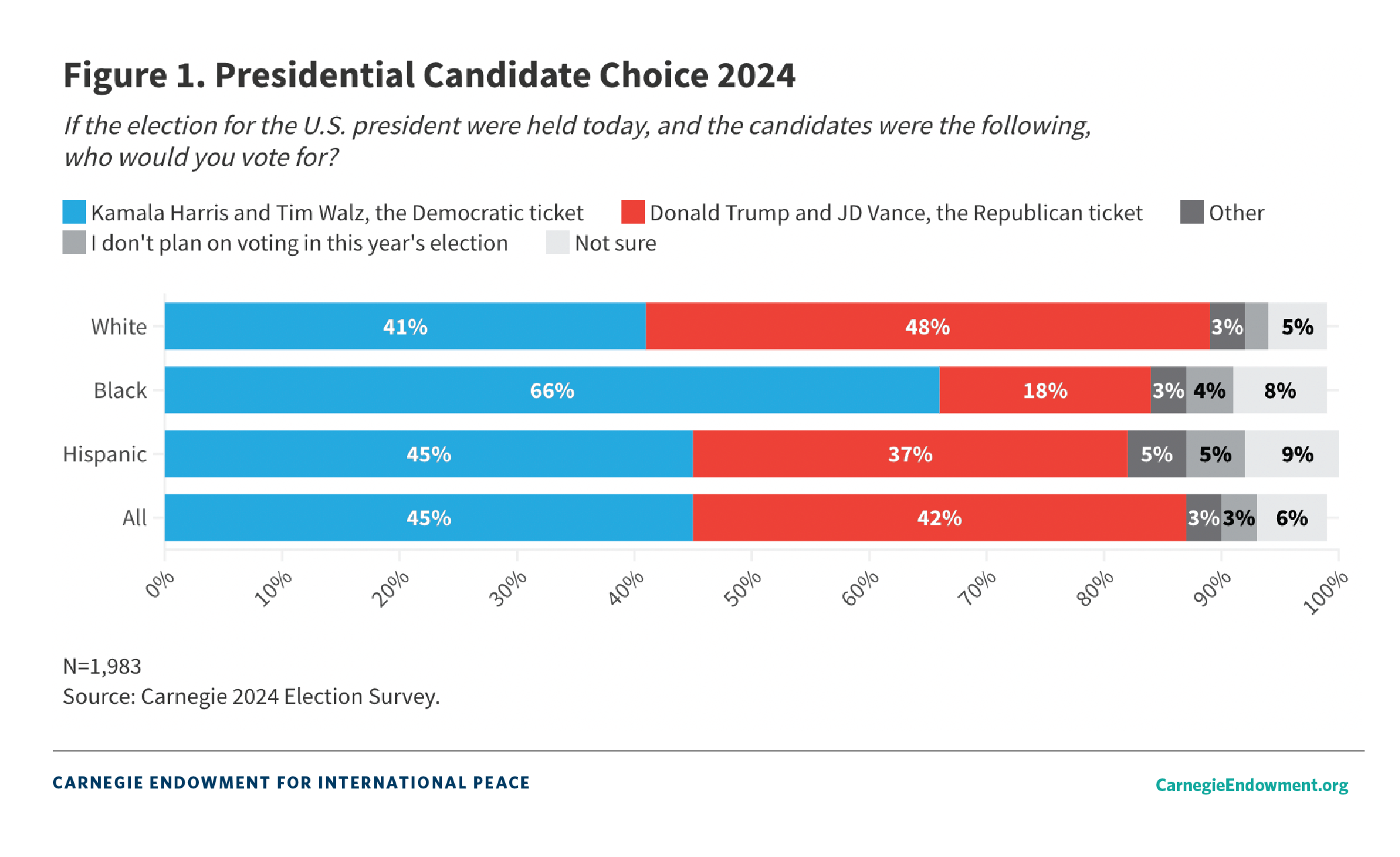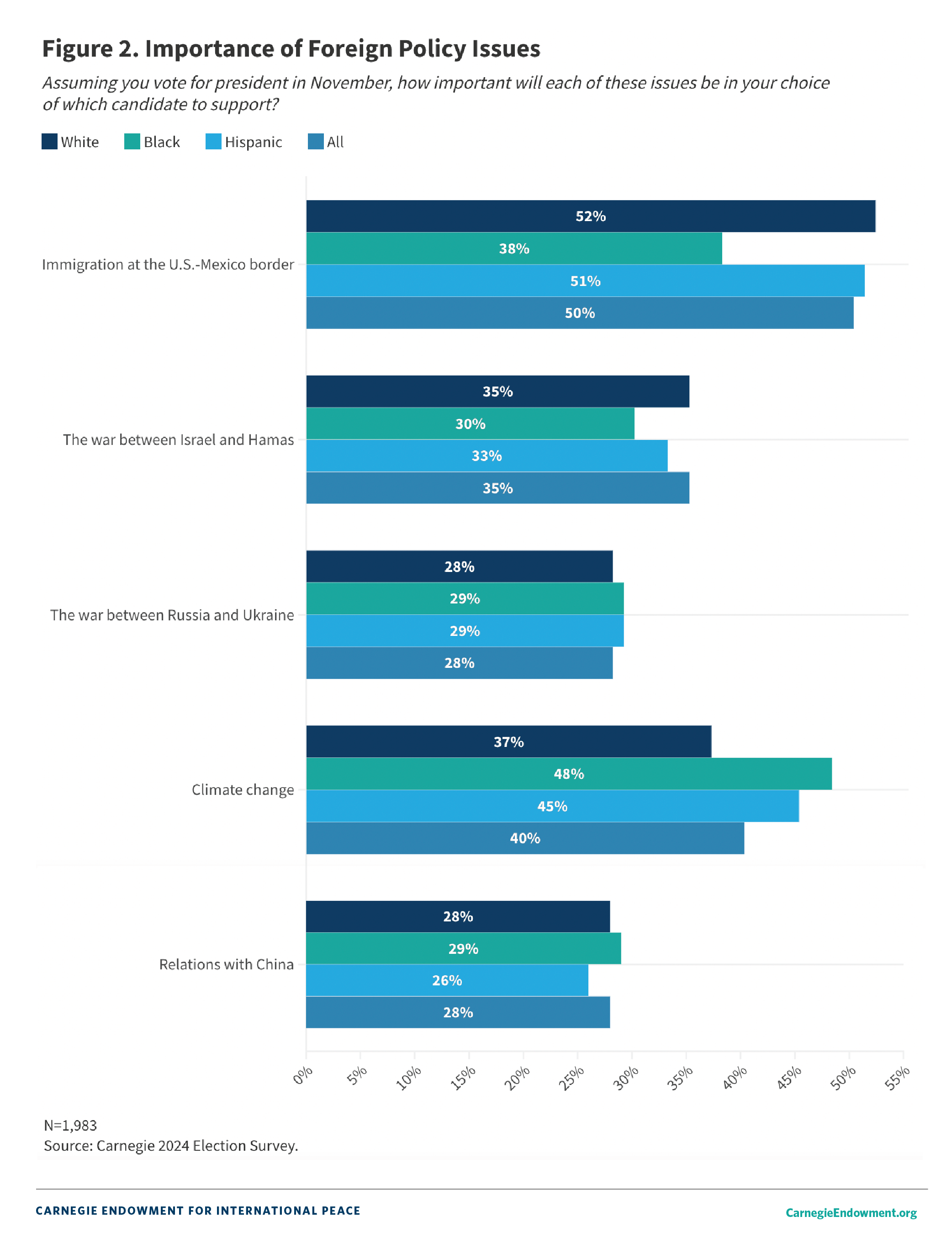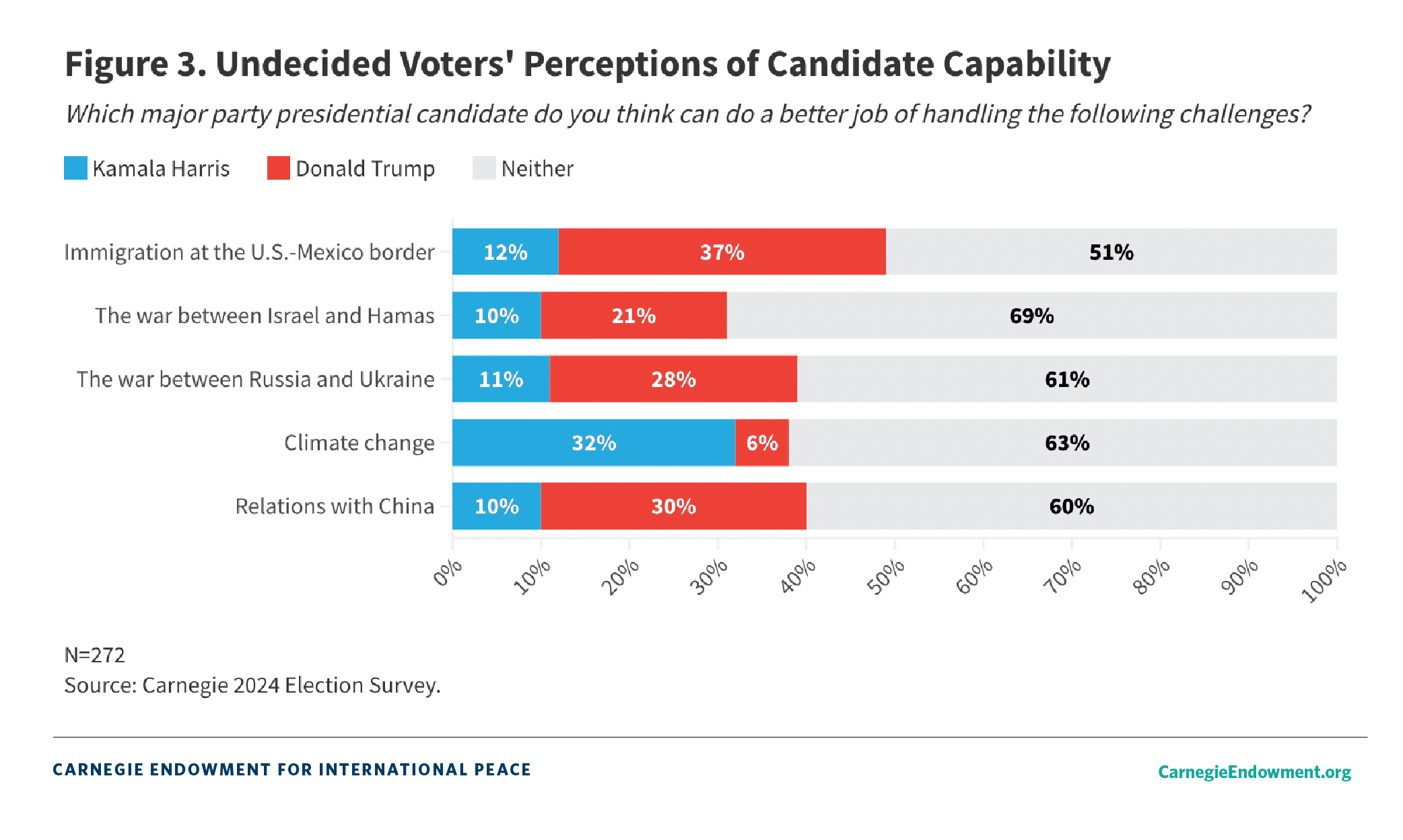Introduction
Conventional wisdom is that U.S. presidential elections are not typically decided by foreign policy issues. However, this year, the prominence of foreign policy topics since election campaigning began and their high profile in recent presidential debates suggest these issues hold some importance for voters.
A survey conducted by the Carnegie Endowment in late August 2024 revealed significant insights into registered voters’ priorities concerning the foreign policy challenges that are prominent in this election cycle:
- Immigration at the U.S.-Mexico border (50 percent) and climate change (40 percent) were the highest-ranked foreign policy concerns among all registered voters, followed by the Israel-Hamas war (35 percent) and the Russia-Ukraine war and relations with China (tied at 28 percent).
- Foreign policy concerns were similar for undecided voters. Climate change and immigration at the U.S.-Mexico border were tied for most importance (42 percent), followed by the war between Israel and Hamas (30 percent).
- Among undecided voters, over half lacked confidence in either candidate’s ability to handle foreign policy issues effectively, while a significant minority preferred Trump regarding relations with China, the Israel-Hamas war, immigration at the U.S.-Mexico border, and the Russia-Ukraine war. In contrast, Harris was favored on climate change. However, neither candidate had majority support on these issues.
- The level of importance assigned to these issues varied across racial groups. Black voters (48 percent) ranked climate change as their top foreign policy concern, while Hispanic (51 percent) and White (52 percent) respondents prioritized immigration at the U.S.-Mexico border.
The full results of the survey, conducted by the Carnegie Endowment’s American Statecraft Program in conjunction with YouGov, are available here.
In what is shaping up to be a tight presidential race, with some voters disillusioned with candidates’ commitments on domestic and foreign policy issues, this article takes a closer look at undecided voters and racial minorities. It examines how important foreign policy is to their self-reported voting intentions and how they evaluate candidates’ ability in managing foreign policy challenges. These groups could sway the election; understanding their takes on key issues is critical.
A Narrow Presidential Race
Restricting the analysis to nationally registered voters (N=1,983), 45 percent of respondents planned to vote for Kamala Harris, 42 percent intended to vote for Donald Trump, 4 percent intended to vote for a third party or independent candidate, 3 percent did not intend to vote at all, and 6 percent were not sure who they would vote for. Taken together, two months before the election, roughly 12 percent of our sample were not decided on either Harris or Trump—a group likely to determine the outcome of the election in November (see table 1).

Our survey findings showing Harris leading Trump by three percentage points are consistent with recent national polls, indicating a highly competitive election. Among White Americans, 41 percent reported that they planned to vote for Harris, compared to 48 percent who said they planned to vote for Trump. The partisan divide was most significant among Black voters, with 66 percent supporting Harris and 18 percent backing Trump.
Numerous recent polls and commentators have noted a shift among Black voters toward waning enthusiasm for the Democratic Party. While our survey does not point to a major political realignment within the Black community, the fact that 18 percent of Black voters report intending to vote for Trump is noteworthy. This finding marks the highest level of support a Republican candidate has garnered among the Black population since 1960, when Richard Nixon secured 32 percent of the Black vote. This does not suggest a drastic evolution in the community’s partisan allegiance, but it is noteworthy given historical African American support for the Democratic Party.
Among Hispanic voters, the partisan gap is narrower, with 45 percent intending to vote for Harris compared to 37 percent for Trump. Asian Americans in our poll leaned toward Harris as well, with 50 percent supporting her and 29 percent favoring Trump.1
Of particular interest to our analysis are individuals who indicated they were unsure, did not plan on voting, or intended to vote for a third-party candidate. Along racial lines, Black (8 percent) and Hispanic (9 percent) voters were more likely to report being unsure about who they would vote for compared to white (5 percent) voters. Additionally, comparable shares of respondents expressed no intention of voting in this year’s election (4 percent of Black, 5 percent of Hispanic, and 2 percent of White voters). Lastly, 3 percent of both White and Black voters and 5 percent of Hispanic voters reported that they planned on voting for a third-party candidate.
Immigration and Climate Change Are the Most Important Foreign Policy Issues for a Majority of American Voters

To understand the issues driving American voters, we presented respondents with a list of issues to rank by importance in deciding which presidential candidate to support. Among all registered voters surveyed, more than seven out of ten respondents listed the economy (76 percent) and inflation (72 percent) as very important issues influencing their vote in November. This response held steady across racial lines, with extreme majorities (over 70 percent) of White, Black, and Hispanic respondents citing the economy and inflation as top concerns. Interestingly, while foreign policy did not rank as highly as the economy, it still held relative importance for many respondents, showing slight variations across demographics. This finding reminds us that a sizable chunk of the American population is attentive and sensitive to how candidates position themselves on seemingly distant issues.
The aggregate topline findings reveal that among the foreign policy issues listed in the survey, immigration at the U.S.-Mexico border was deemed the most important by 50 percent of respondents, followed by climate change at 40 percent. The war between Israel and Hamas was considered very important by 35 percent of respondents, while both the Russia-Ukraine war and relations with China were seen as very important by 28 percent of respondents (see table 2).
Immigration at the U.S.-Mexico Border and Climate Change Are Undecided Voters’ Top Foreign Policy Priorities
Undecided voters’ foreign policy priorities bear significant resemblance to those of voters who are decided. For undecided voters, climate change (42 percent) and immigration at the U.S.-Mexico border (42 percent) were tied for most importance, followed by the war between Israel and Hamas (30 percent). Relations with China (22 percent) and the war between Russia and Ukraine (19 percent) were of the least importance to this demographic.
Among Black, White, and Hispanic undecideds, priorities on foreign policy issues varied, with climate change emerging as the top concern for undecided Black voters, immigration at the U.S.-Mexico border most significant for undecided White voters, and immigration and climate change equally important for undecided Hispanic voters.
Forty-four percent of Black undecided voters reported climate change as the most important foreign policy issue. Immigration at the U.S.-Mexico border (27 percent) was the second-most important issue for this group, coming in nearly 20 percentage points behind climate change. The war between Israel and Hamas (23 percent), relations with China (19 percent), and the war between Russia and Ukraine (19 percent) were less popular priorities. For White undecided voters, immigration at the U.S.-Mexico border (47 percent) was the top foreign policy priority, followed by climate change (42 percent), the war between Israel and Hamas (28 percent), relations with China (24 percent), and the war between Russia and Ukraine (20 percent).
Among Hispanic undecided voters, immigration at the U.S.-Mexico border and climate change were tied for the most important foreign policy issue (37 percent), followed by the war between Israel and Hamas (30 percent), the war between Russia and Ukraine (16 percent), and relations with China (14 percent).
Undecided Voters Are Split on Candidates’ Handling of Foreign Policy Issues

With both candidates likely to clarify their policies in a bid to capture undecided voters in the final weeks before the election, we assessed which candidate respondents felt could better handle the listed foreign policy challenges. Partisan identity clearly influences respondents’ evaluations of Trump and Harris’s abilities; an overwhelming majority of Harris supporters believe she can better address these challenges, and the same holds true among Trump supporters. This trend is also observed among White, Black and Hispanic voters.
However, among undecided voters, the outcome is less clear. While more than half of respondents in this category lack confidence in both candidates’ ability to effectively handle foreign policy issues, a notable minority expresses a clear preference for one candidate over the other. Topline findings for all undecided voters reveal that, between Harris and Trump, Trump is preferred on the two most important domestic issues: economy (33 percent versus 19 percent) and inflation (34 percent versus 16 percent). Regarding foreign policy, Trump is preferred in handling relations with China (30 percent versus 10 percent), the Israel-Hamas war (21 percent versus 10 percent), immigration at the U.S.-Mexico border (37 percent versus 12 percent), and the Russia-Ukraine war (28 percent versus 11 percent). In contrast, Harris is favored on climate change (32 percent versus 6 percent) (see table 3).
On the two top domestic concerns, undecided Black respondents felt Harris could do a better job on the economy (38 percent versus 20 percent). However, opinions were more divided on who could handle inflation, with 22 percent favoring Harris and 21 percent favoring Trump. In terms of foreign policy, undecided Black voters preferred Harris to handle climate change, with 27 percent of respondents believing she would do a better job compared to 9 percent for Trump. The same holds true for undecided White respondents (33 percent versus 4 percent) and Hispanic respondents (21 percent versus 11 percent).
For undecided Black respondents, Trump was favored on several issues: immigration at the U.S.-Mexico border (32 percent versus 13 percent), relations with China (32 percent versus 12 percent), the war between Russia and Ukraine (24 percent versus 17 percent). On the war between Israel and Hamas, undecided Black respondents were evenly split, with 14 percent favoring Harris compared to 13 percent favoring Trump.
White undecided respondents favored Donald Trump on the economy (37 percent versus 17 percent) and inflation (39 percent versus 17 percent). On foreign policy, they also favored him on immigration at the U.S.-Mexico border (42 percent versus 11 percent), the war between Israel and Hamas (23 percent versus 9 percent), the war between Russia and Ukraine (28 percent versus 11 percent), and relations with China (33 percent versus 9 percent). However, they favored Harris on climate change (33 percent versus 9 percent).
Unlike undecided White and Black respondents, undecided Hispanic respondents said Harris could do better on immigration (21 percent versus 14 percent). However, on the war between Israel and Hamas (20 percent versus 10 percent), the war between Russia and Ukraine (28 percent versus 4 percent), and relations with China (23 percent versus 9 percent), Hispanic undecided respondents said Trump could do a better job.
Climate Change Is Black Voters’ Top Priority—Except Black Trump Supporters
In light of the extensive commentary in recent months around the Joe Biden and Kamala Harris administration’s Gaza policy impacting voter enthusiasm among the Black community (a key demographic in any potential Harris victory in November), our survey specifically examined which foreign policy issues mattered most to African American voters. Among all Black registered voters, climate change was the most important (48 percent), followed by immigration at the U.S.-Mexico border (38 percent), the war between Israel and Hamas (30 percent), the war between Ukraine and Russia (29 percent), and relations with China (29 percent).
Notably, for White (52 percent) and Hispanic (51 percent) respondents, immigration at the U.S.-Mexico border was the most important foreign policy issue by a double-digit difference compared to Black voters. This divergence in views on immigration and its influence on voter decisionmaking is worthy of further exploration, especially given that immigration will remain relevant in future elections.
Interestingly, two issues were regarded with the same level of importance across racial groups: the Russia-Ukraine war, rated very important by 28 percent of White, 29 percent of Black, and 29 percent of Hispanic respondents; and relations with China, rated as very important by 28 percent of White, 29 percent of Black, and 26 percent of Hispanic respondents. The war between Israel and Hamas was also of roughly equal significance across racial groups, with 35 percent of White, 30 percent of Black, and 33 percent of Hispanic respondents considering it very important.
Just like the larger voting public, Black Americans prioritize issues largely in reflection of their affiliated party’s policy positions. Among Black Harris supporters, more than half felt climate change (53 percent) was the most important issue, followed by the border (37 percent), the war between Russia and Ukraine (32 percent), the war between Israel and Hamas (30 percent), and relations with China (29 percent). Conversely, among Black Trump supporters, about half (49 percent) reported the border was the most important issue, with climate change (36 percent), relations with China (36 percent), and the war between Israel and Hamas (35 percent) all tied for second, followed by the war between Russia and Ukraine (28 percent).
While Black Americans generally hold liberal views on immigration, the recent influx of migrants into economically deprived neighborhoods in cities like New York and Chicago, coupled with the rise of what some describe as “nativist” movements in Black communities, may explain why immigration ranked higher among Black Trump supporters and why roughly two in ten Black voters support Trump. This is not to suggest that correlation equals causation; rather, it is important to note that this level of support for a Republican candidate is unprecedented and Trump’s alarmist rhetoric on immigration may speak to the sensibilities of some Black voters.
Conclusion
This presidential election will likely follow the pattern of previous American elections, with bread-and-butter issues like the economy and inflation (or the cost of living) being top priorities for most voters. However, as indicated by the data, certain foreign policy issues such as climate change, immigration at the U.S.-Mexico border, and the Israel-Hamas war could potentially influence voter decisions, especially among key demographics like racial minorities and the youth. In the final hours before the election, it might be beneficial for each campaign to clearly articulate how its policies are distinct from those of the other candidate and how its approach to these global challenges will ultimately improve the well-being of Americans at home.
Survey Design
The data analyzed here are drawn from a survey of 2,300 U.S. adults, designed by scholars at the Carnegie Endowment for International Peace and conducted by YouGov from August 27, 2024–September 5, 2024. Overall results have a margin of error of plus or minus 2.3 percent, with higher margins of error for individual demographic subcategories. In response to widespread speculation about diminishing enthusiasm among Black voters, particularly before Biden exited the race, YouGov oversampled Black Americans to ensure the study could draw meaningful inferences about segments of the Black community, particularly those not decided on voting for either Harris or Trump.
Correction: An error in figure 3 has been corrected to reflect the issues discussed in the succeeding section of the article.
1The sample size for Asian Americans in the survey is not large enough to draw statistical conclusions from and will not be included in the remainder of this article’s analysis.
.jpg)